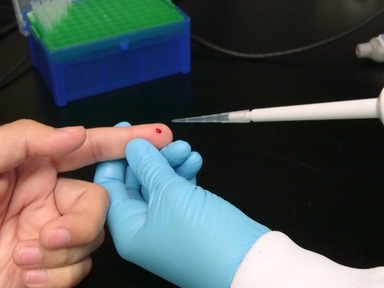Detection of Rhesus Factor in Human Blood Samples using Magnetic Levitation
Transcript
Take a paramagnetic gadolinium solution responsive to external magnetic fields.
Introduce fluorescently labeled Rhesus or Rh factor-positive and unlabeled Rh factor-negative blood samples.
Add anti-RhD antibody-coated low-density polymer beads and uncoated high-density beads.
Anti-RhD antibodies bind to RhD-antigens on Rh-positive RBCs, forming bead-RBC complexes.
Now, load the sample into a capillary tube and seal it. Place the tube between magnets in the magnetic levitation device.
In the magnetic field generated by like-poles-facing magnets, the paramagnetic solution exerts magnetic and buoyant forces on sample components, causing them to levitate at heights proportional to their densities.
Low-density and high-density beads levitate at the top and bottom of the capillary, respectively, establishing density height references.
Blood cells, being diamagnetic, are repelled by a strong magnetic field near the magnets and levitate at an intermediate position.
The bead-RBC complexes levitate between low-density beads and RBCs, with fluorescent cells in this layer confirming Rh-positive RBC presence.
ABOUT JoVE
Copyright © 2024 MyJoVE Corporation. All rights reserved


